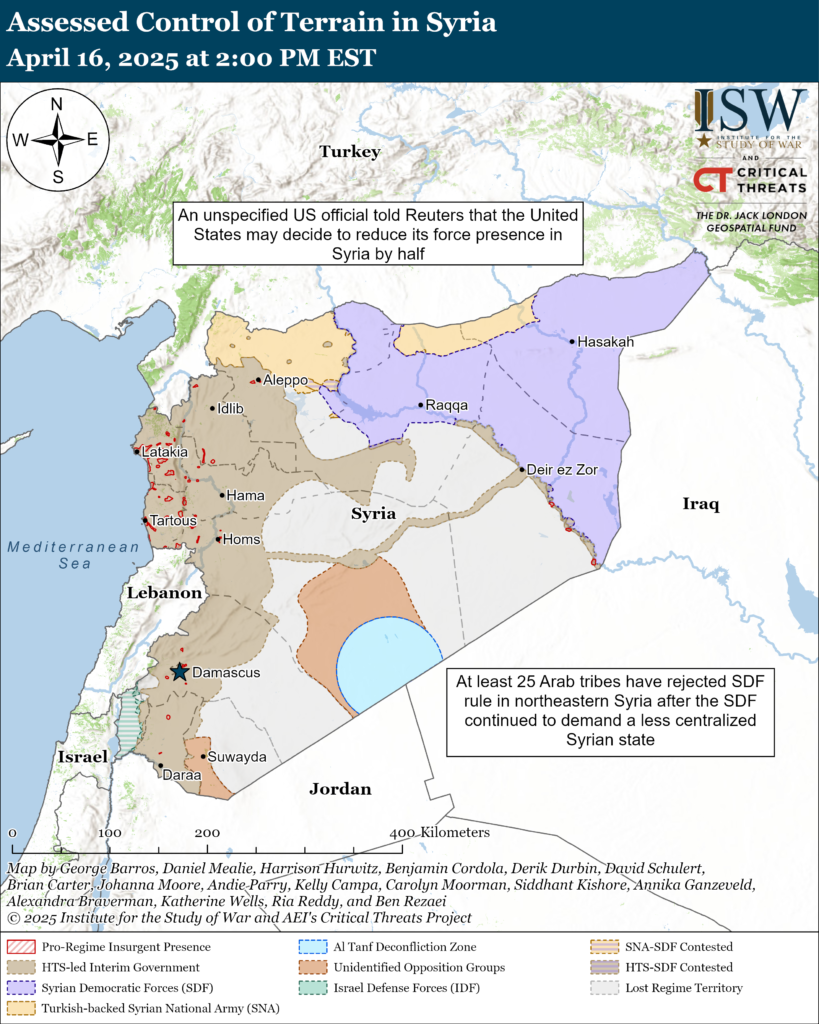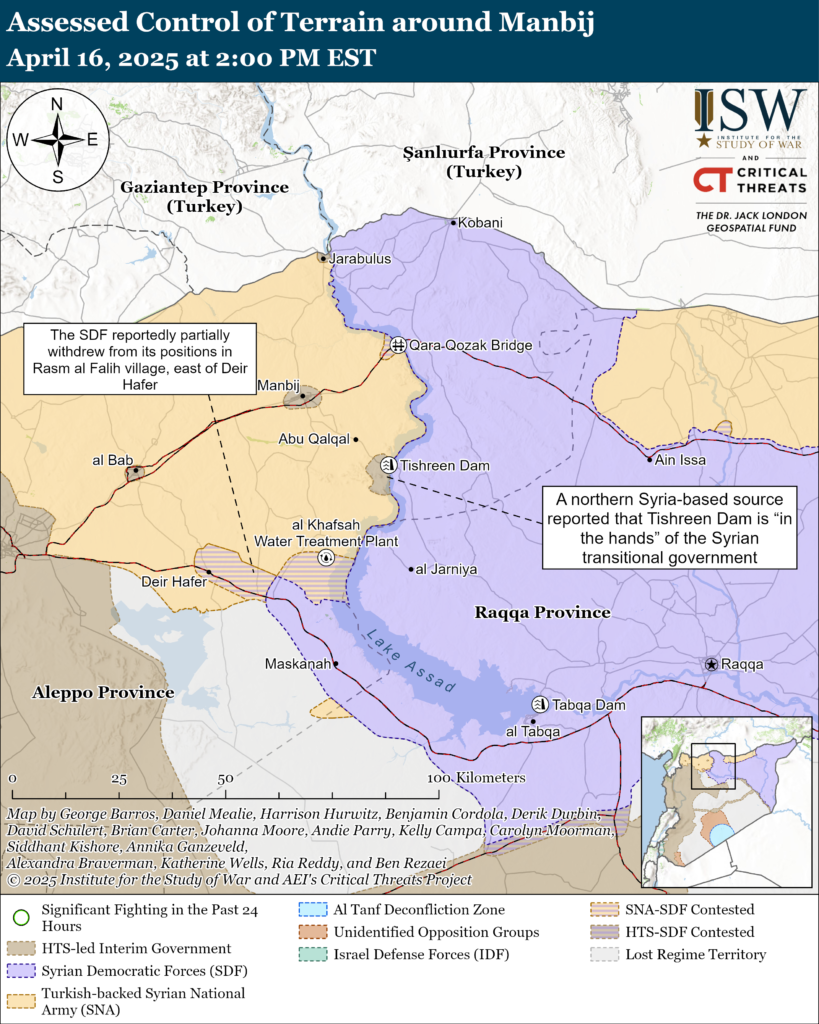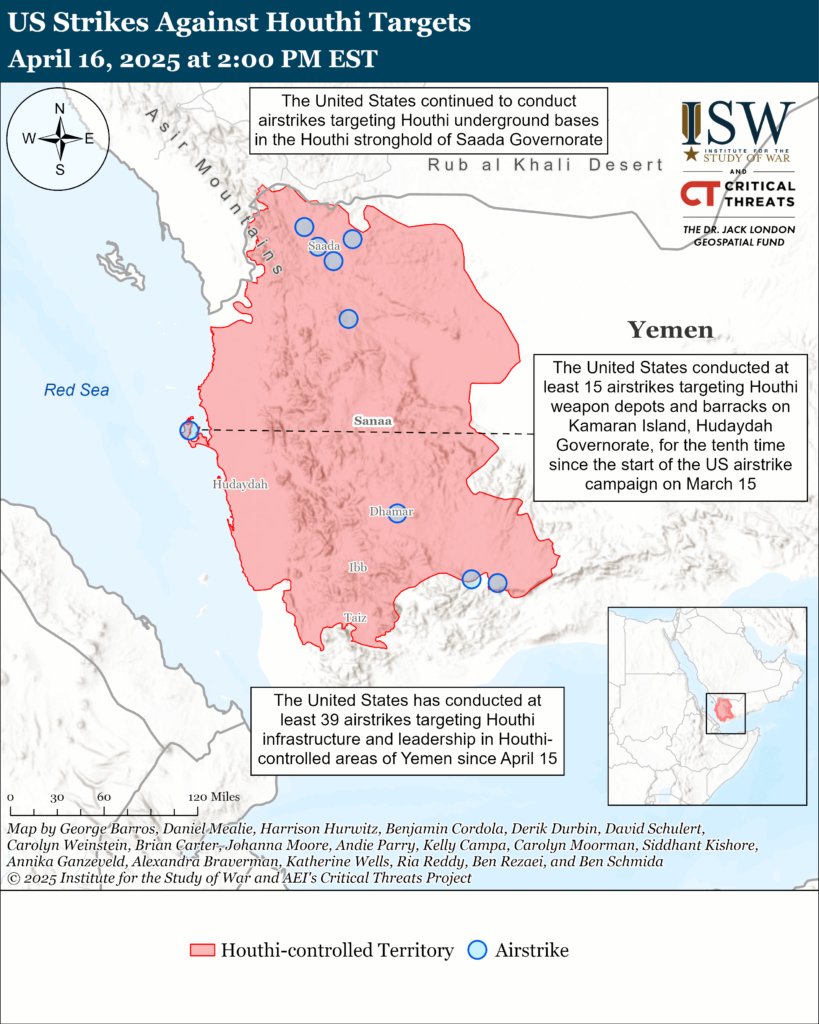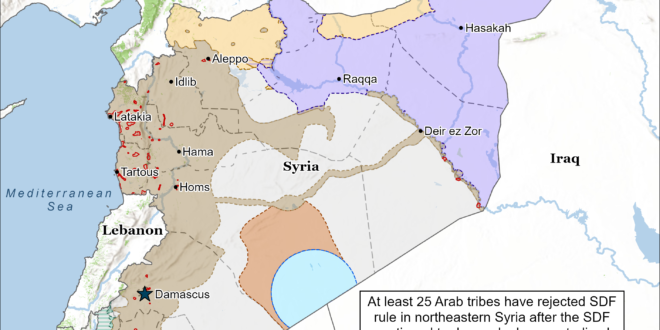Iran is unlikely to accept zero uranium enrichment and full dismantlement of its nuclear program. Iranian Foreign Affairs Minister Abbas Araghchi stated on April 16 that uranium enrichment is a “real and undeniable right” and “not subject to negotiation.”[i] Araghchi stated that “contradictory” US positions do not help the negotiations and emphasized that “Iran must hear Washington’s real stance” to assess whether a framework agreement is possible. Araghchi likely referred to recent remarks by US Special Envoy to the Middle East Steve Witkoff regarding “zero uranium enrichment,” in which Witkoff originally said Iran could enrich uranium to 3.67 percent before clarifying that any nuclear deal must “stop and eliminate” Iranian nuclear enrichment.[ii] Iranian officials have consistently rejected the concept of zero uranium enrichment and stated that Iran may reduce enrichment to Joint Comprehensive Plan of Action (JCPOA) levels.[iii] Iranian Expediency Discernment Council member and former Islamic Revolutionary Guards Corps (IRGC) Commander Mohsen Rezaei separately stated on X on April 16 that US statements reflect ”confusion and disarray” within the Trump administration and reinforce Iranian distrust caused by the U S withdrawal from the JCPOA in 2018.[iv] Rezaei’s remarks align with Iranian Supreme Leader Ali Khamenei’s guidance in his April 15 speech. Khamenei said Iran must “proceed carefully” in the US-Iran talks and signaled deep skepticism toward the United States while supporting negotiations to mitigate pressure and preserve regime stability.[v] Khamenei will likely remain skeptical of any agreement with the Trump administration, given Trump’s decision to withdraw from the JCPOA.[vi]
Senior Iranian officials appear increasingly concerned about a potential US or Israeli strike on Iran. Khatam ol Anbia Air Defense Headquarters Commander Brigadier General Alireza Sabahi Fard visited Fordow Air Defense Group in Qom Province on April 16 to evaluate the unit’s operational readiness.[vii] The air defense site, also known as Hazrat-e Masoumeh Air Defense Group, is located approximately 16 km east of the Fordow Fuel Enrichment Plant (FFEP).[viii] Fordow is a highly fortified underground uranium enrichment facility built into a mountain and reportedly designed to withstand military strikes, making it one of Iran’s most secure nuclear sites.[ix] Iran previously conducted air defense exercises near the Fordow nuclear facility in January 2025.[x] Sabahi Fard’s visit marks the fourth stop in the ongoing Iranian air defense inspections that began on April 4.[xi]
Recent statements by unspecified US officials suggested the reported US drawdown in Syria will decrease US forces to no fewer than 1,000, roughly the same number of US forces present in Syria before the recent increase in 2024. An unspecified US official told Reuters on April 15 that the United States may decide to reduce its force presence in Syria by half, which would be consistent with the size of previous US deployments in Syria.[xii] The official said that the US plans to reduce its presence in Syria and that this could reduce US troops to approximately 1,000 personnel.[xiii] A second unspecified US official said that the size of the US withdrawal is uncertain but was ”skeptical of a decrease of that scale, suggesting that the drawdown will be no less than 1,000 personnel.[xiv] Earlier reports in Israeli media lacked this context and reported that the United States will begin to withdraw from Syria by mid-June 2025.[xv] The Trump administration ordered the US Defense Department to begin preparing plans for the withdrawal of US service members from Syria in early February 2025.[xvi] The United States maintained roughly 900 US personnel in Syria between 2019 and 2024, when the United States increased the number of troops to 2,000 US personnel to meet CENTCOM requirements.[xvii] It is unclear if the October 7 War or the fall of Assad increased CENTCOM’s force requirements.
At least 25 Arab tribes have condemned the US-backed Syrian Democratic Forces (SDF) since April 14, probably in reaction to continued SDF demands to decentralize Damascus’s control in northeastern Syria.[xviii] The tribes rejected what they called a “separatist project” imposed on Arab-majority areas.[xix] ”Separatist project” is an often-used reference to the SDF’s efforts to secure decentralization and federalization in northeastern Syria under the transitional government. The SDF does not seek to secede from Syria. Unspecified Arab tribal leaders recently met with the SDF in Raqqa Province in response to the SDF’s call for a show of support.[xx] Other Arab tribal leaders condemned these meetings and clarified that the individuals involved did not represent their tribes’ official positions.[xxi] The tribal leaders instead expressed their support for the transitional government in Damascus. Some Arab political groups announced the formation of a new council on April 15 to oppose SDF control in northeastern Syria and to present a unified front for negotiations with Damascus.[xxii] The SDF has already withdrawn from Aleppo City but has not yet negotiated with the transitional government over territorial redistribution in the Arab-majority Raqqa and Deir ez Zor provinces.[xxiii] SDF Commander Mazloum Abdi has repeatedly called for a federalist structure to maintain the SDF’s control in northeastern Syria.[xxiv] The recent condemnations, the formation of this council, and the reported creation of anti-SDF Arab militia organizations reflect long-standing tension between the SDF and the local Arab communities it governs.[xxv] The SDF has historically used a heavy-handed approach with Arab communities and suppressed certain Arab groups while empowering others, which has alienated some local Arabs and increased support for the HTS-led transitional government.[xxvi]

The United Arab Emirates (UAE) is probably exploring the possibility of a Yemeni government offensive against the Houthis, while the UAE also attempts to avoid triggering Houthi attacks on the Emirates. The UAE has discussed a ground offensive with US officials in recent weeks.[xxvii] US private security contractors are also reportedly advising Yemeni factions backed by the UAE to support a ground offensive, suggesting possible Emirati involvement..[xxviii] The UAE has extensively used private contractors in Yemen, and it is doubtful that UAE-backed factions could hire private contractors without Emirati approval.[xxix] Bloomberg separately reported on April 16 that the Yemeni Armed Forces are discussing a potential ground offensive with the United States and Gulf Arab allies to remove the Houthis from the Red Sea coast, citing people involved in the discussions.[xxx]
A senior Emirati official denied reports that the UAE is involved in a ground campaign plan, probably out of concern that Emirati involvement in a Yemeni government offensive would trigger attacks.[xxxi] The UAE fears Houthi attacks on Abu Dhabi and Dubai because these attacks could threaten the Emirati economy if they were sustained over a longer period. These fears are particularly poignant in the aftermath of a nearly 18-month Houthi attack campaign targeting Israel, which is 300km further from Yemen than Dubai. A previous successful Emirati-backed offensive against the Houthis in January 2022 triggered Houthi attacks on Abu Dhabi, after which the Emirati-backed offensive promptly stopped.[xxxii]
A Saudi official also denied reports of a Yemen Armed Forces ground offensive against the Houthis, according to Reuters on April 16.[xxxiii] Unspecified Saudi officials told the Wall Street Journal on April 14 that Saudi Arabia would not get involved in a ground offensive over concerns that Saudi Arabia’s participation would cause the Houthis to resume drone and missile attacks targeting Saudi territory.[xxxiv] The Houthis launched numerous drone and missile attacks targeting Saudi sites, mostly energy infrastructure, from the start of the Saudi-Emirati-led coalition air campaign against the Houthis in Yemen in 2015 until the ceasefire in 2022.[xxxv]
Oman-based Houthi spokesperson and chief negotiator Mohammed Abdulsalam has a multitude of different responsibilities within the Houthi regime, including smuggling and intelligence operations, according to Yemeni media investigations.[xxxvi] An independent Yemeni defense outlet connected Abdulsalam to a Houthi smuggling network managing operations across Omani border checkpoints, in addition to operations via the Red Sea.[xxxvii] Abdulsalam also reportedly manages a Yemen-based communications company that imports equipment that can be repurposed for domestic surveillance, military communications, and weapons production from the international market, including China, to Houthi-controlled territory.[xxxviii] This company facilitates the Houthis’ internal communication and surveillance over the population in Houthi-controlled territory.[xxxix]
The Houthis, supported by Iran, have long used communications equipment to maintain internal control and oppress the Yemeni population.[xl] The Iranian regime has experience building a police and surveillance state and likely seeks to share this expertise to enhance the already strong Houthi control over Yemen’s telecommunications sector and advance Houthi efforts to build a similarly strong authoritarian state.
The United States authorized limited communications-related transactions with the Houthis that would otherwise be prohibited under US terrorism sanctions from March 5, 2025.[xli] The license permits telecommunications transmissions within Yemen involving the Houthis but does not permit the sale of equipment or network capacity. The waiver allows internet-based communications services to Yemen, including messaging, social media, email, and cloud services, and permits mail delivery between the United States and Yemen, as long as these activities do not involve other sanctioned individuals. Financial transfers to Houthis remain largely prohibited except for specific purposes like taxes and utility payments. This updated license replaces the previous version from January 2024.
Key Takeaways:
Iranian Nuclear Negotiations: Iran is unlikely to accept zero uranium enrichment and full dismantlement of its nuclear program. Iranian Foreign Affairs Minister Abbas Araghchi stated on April 16 that uranium enrichment is a “real and undeniable right” and “not subject to negotiation.”
US Drawdown in Syria: Recent statements by unspecified US officials suggested the reported US drawdown in Syria will decrease US forces to no less than 1,000, which is roughly the same amount of US forces present in Syria prior to the recent increase in 2024.
Syrian Democratic Forces and Tribal Relations: At least 25 Arab tribes have condemned the US-backed Syrian Democratic Forces (SDF) since April 14, probably in reaction to continued SDF demands to decentralize Damascus’s control in northeastern Syria.
Yemeni Ground Offensive: The United Arab Emirates (UAE) is probably exploring the possibility of a Yemeni government offensive against the Houthis while the UAE also attempts to avoid triggering Houthi attacks on the Emirates. A senior Emirati official denied reports that the UAE is involved in a ground campaign plan, probably out of concern that Emirati involvement in a Yemeni government offensive would trigger attacks.
Houthi Telecommunications: Oman-based Houthi spokesperson and chief negotiator Mohammed Abdulsalam has a multitude of different responsibilities within the Houthi regime, including smuggling and intelligence operations, according to Yemeni media investigations. The Houthis, supported by Iran, have long used communications equipment to maintain internal control and oppress the Yemeni population.
Syria
A northern Syria-based source reported that Tishreen Dam is under Syrian transitional government control on April 15 amid the SDF withdrawal from positions in Aleppo Province.[xlii] The SDF has reportedly withdrawn in groups from Tishreen Dam over the past two weeks in accordance with a recent ceasefire and integration agreement with the Syrian government.[xliii] A northern Syria-based source reported that dam employees are now managing the dam, but that some “logistical matters” need to be arranged before the Syrian transitional government can announce its official supervision of the dam.[xliv] Syrian 60th Division commander Brigadier General Awad Mohammad told state media that the dam’s handover will be announced in the coming days.[xlv] The 60th Division deployed to villages west of Tishreen Dam on April 14 after the SDF withdrew from its positions there.[xlvi]
The northern Syria-based source also reported that the SDF partially withdrew from its positions in Rasm al Falih village, east of Deir Hafer.[xlvii] The SDF is expected to withdraw from Deir Hafer and Maskana in the coming days.[xlviii]
Two historically Kurdish neighborhoods continued to reintegrate into Aleppo City. About 1,000 Kurdish fighters have reportedly withdrawn from the two neighborhoods since April 4.[xlix] Representatives from the two neighborhoods held their first official meeting on April 15 with the Aleppo City Council and Aleppo Deputy Governor Ali Hanoura to discuss coordinating municipal work and services.[l] Members of the committee that Syrian Transitional President Ahmed al Shara appointed to negotiate with the SDF entered the two neighborhoods on April 16 in order to oversee the integration of the agreement.[li]

Syrian authorities arrested an unspecified number of individuals who made sectarian comments about the Alawite Sheikh Ahmad al Shaabani shrine in Khirbat al Akrad, Tartous Province, on April 15.[lii] A social media footage reportedly showed individuals wearing military uniforms making sectarian comments about the Alawite Shrine. Tartous authorities launched an investigation after Tartous residents complained.[liii] Tartous authorities did not specify if the arrested individuals were Syrian security personnel, however.
Seven unidentified gunmen opened fire on a General Security Services (GSS) patrol in Sheikh Maskin, Daraa Province, on April 16.[liv] The GSS patrol was attempting to recover stolen public property.[lv] The patrol responded to the sources of the fire and engaged the gunmen.[lvi] At least one gunman was killed and three were wounded, while the other attackers fled.[lvii] Security forces captured one of the injured gunmen and confiscated several weapons, including a rocket-propelled grenade (RPG) launcher and small arms.[lviii]
The Interior Ministry announced on April 16 that it will appoint an official to oversee the GSS and police commands in each Syrian province, thus centralizing control over both forces.[lix] Transitional Interior Minister Anas Khattab said that all police and security branches will report to this Interior Ministry official, who in turn will report directly to the Interior Ministry–not the provincial governor.[lx] The GSS was Hayat Tahrir al Sham (HTS)’s main policing force in northwestern Syria and has become the transitional government’s gendarmerie across Syria to fill the security vacuum after the fall of the regime.[lxi] The Interior Ministry has since opened recruitment centers across government-controlled territory.[lxii] The centralization of each province’s expanding GSS units and locally-based police seeks to achieve unity of command and decreases the likelihood that the GSS or local police would come into competition with each other. Khattab’s future appointments to these newly created roles will likely inform how the transitional government intends to approach security in each province, particularly in sensitive areas such as Syria’s coastal region.
Yemeni Foreign Minister Shaye al Zindani announced on April 15 that the Yemeni embassy in Damascus will reopen soon.[lxiii] The Yemeni embassy in Damascus has been closed since 2011 after most countries severed relations with the former Assad regime, but the Houthis previously maintained their own ambassador to the Assad regime in Damascus.[lxiv] Zindani stated that Yemen has been in contact with the Syrian interim government to reopen the embassy since the Assad regime was overthrown in December 2024.[lxv] A Yemeni delegation plans to visit Damascus on April 21 or 23.[lxvi]
Iraq
Axis of Resistance objectives:
Strengthen Iranian and Axis of Resistance influence over the Iraqi state and society
Harden the Iraqi government against internal dissent
Nothing Significant to report.
Arabian Peninsula
Axis of Resistance objectives:
Harden the Houthi regime against internal dissent in Houthi-controlled areas
Destroy the anti-Houthi opposition in order to control all of Yemen
Erode Israeli will to continue the war in the Gaza Strip
US Central Command (CENTCOM) has conducted at least 39 airstrikes targeting Houthi infrastructure and leadership in Houthi-controlled areas of Yemen on April 15.[lxvii] CENTCOM conducted at least 15 airstrikes targeting reported Houthi barracks and weapons depots on Kamaran Island, Hudaydah Governorate.[lxviii] These airstrikes mark the tenth time that CENTCOM has targeted Houthi infrastructure on Kamaran Island since the start of the US air campaign on March 15.[lxix] CENTCOM conducted at least 15 airstrikes targeting Houthi underground bases in the Houthi stronghold of Saada Governorate.[lxx] Five CENTCOM strikes also targeted reported Houthi training camps in al Bayda Governorate.[lxxi] CENTCOM launched an unspecified number of airstrikes targeting likely Houthi infrastructure in Mayfaar Ans District, Dhamar Governorate, and Harf Sufyan District, Amran Governorate.[lxxii]

The Palestinian Territories and Lebanon
Axis of Resistance objectives:
Erode the will of the Israeli political establishment and public to sustain clearing operations in the Gaza Strip
Reestablish Hamas as the governing authority in the Gaza Strip
Rebuild and reestablish Hezbollah in southern Lebanon
Establish the West Bank as a viable front against Israel
Nothing significant to report.
CTP-ISW will not be covering the new Israeli operation in the Gaza Strip. We have reprioritized our Middle East coverage to focus on Iran’s nuclear program, Iranian domestic security, and Iranian efforts to rebuild its networks in the Levant, including the Palestinian Territories. Given that Israel and its partners have destroyed Hamas’ military organization and severed the group’s ability to resupply itself, we are now focused on how Iran seeks to rebuild its lines of communication with Hezbollah and Hamas through Syria.
Iranian Decision-Making, Internal Dynamics, and Foreign Policy
The Iranian rial appreciated from 890,000 rials to one US dollar on April 15 to 875,000 rials to one US dollar on April 16.[lxxiii]
Senior Iranian political and defense officials met with Tajik Defense Minister Lieutenant General Emomali Sobirzoda in Tehran on April 15 and 16. Supreme National Security Council Secretary Ali Akbar Ahmadian, Armed Forces General Staff Chief Major General Mohammad Bagheri, and Artesh Commander Major General Abdol Rahim Mousavi separately met with Sobirzoda during his visit to Tehran.[lxxiv] Bagheri and Sobirzoda discussed efforts to combat terrorism, likely referring to bilateral cooperation regarding Afghanistan.[lxxv] Sobirzoda previously met with Defense and Armed Forces Logistics Minister Brigadier General Aziz Nasir Zadeh on April 15 to discuss strengthening defense cooperation.[lxxvi] Iran and Tajikistan previously signed 22 memoranda of understanding (MoUs) and a joint statement on bilateral cooperation in January 2025.[lxxvii] Iran has increased defense cooperation with Tajikistan in recent years. Iran opened a drone production facility in Dushanbe in 2022, for example.[lxxviii]
Israeli media reported on April 16 that unspecified US and Israeli officials discussed assassinating IRGC Aerospace Force Commander Brigadier General Amir Ali Hajizadeh after the Iranian attack on Israel in October 2024, but ultimately decided against it.[lxxix] The report noted that Israel instead decided to launch an attack that targeted Iranian air defense systems and missile production capabilities.[lxxx] Hajizadeh was the officer responsible for planning and executing the April 13 and October 1, 2024, Iranian attacks on Israel.
The Iran Update provides insights into Iranian and Iranian-sponsored activities abroad that undermine regional stability and threaten US forces and interests. It also covers events and trends that affect the stability and decision-making of the Iranian regime. The Critical Threats Project (CTP) at the American Enterprise Institute and the Institute for the Study of War (ISW) provides these updates regularly based on regional events.
CTP-ISW defines the “Axis of Resistance” as the unconventional alliance that Iran has cultivated in the Middle East since the Islamic Republic came to power in 1979. This transnational coalition is comprised of state, semi-state, and non-state actors that cooperate to secure their collective interests. Tehran considers itself to be both part of the alliance and its leader. Iran furnishes these groups with varying levels of financial, military, and political support in exchange for some degree of influence or control over their actions. Some are traditional proxies that are highly responsive to Iranian direction, while others are partners over which Iran exerts more limited influence. Members of the Axis of Resistance are united by their grand strategic objectives, which include eroding and eventually expelling American influence from the Middle East, destroying the Israeli state, or both. Pursuing these objectives and supporting the Axis of Resistance to those ends have become cornerstones of Iranian regional strategy.
 Eurasia Press & News
Eurasia Press & News


